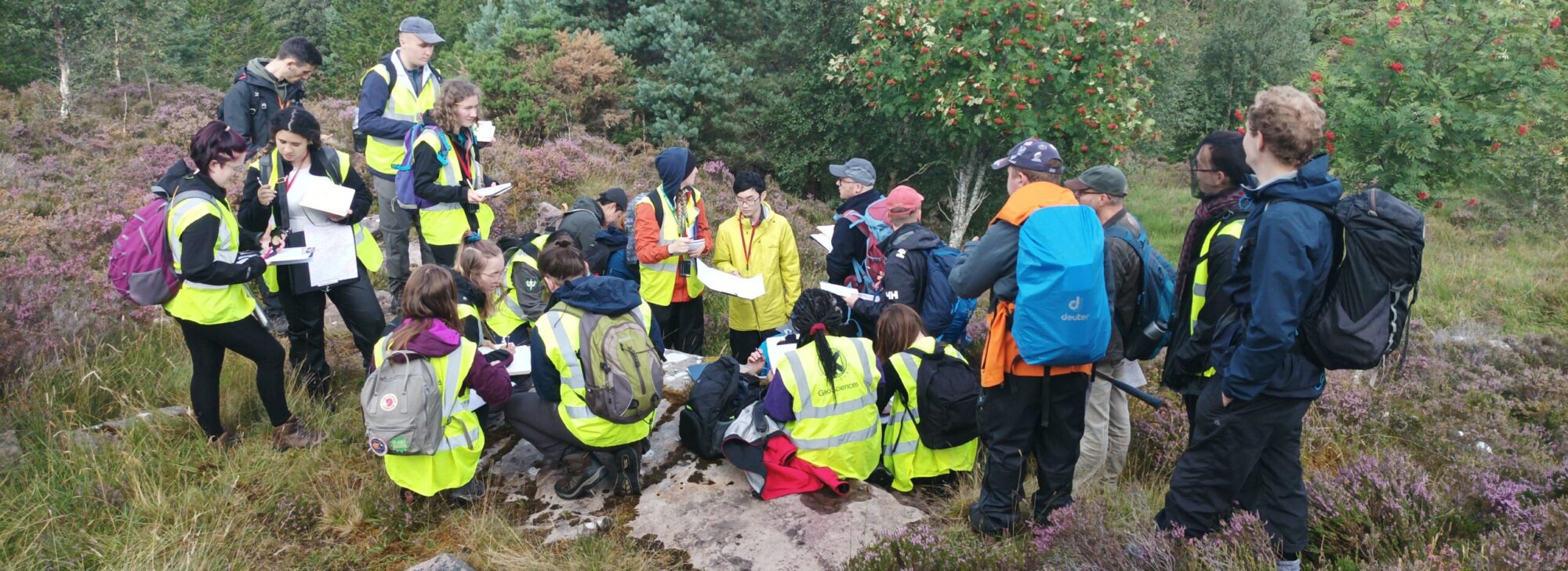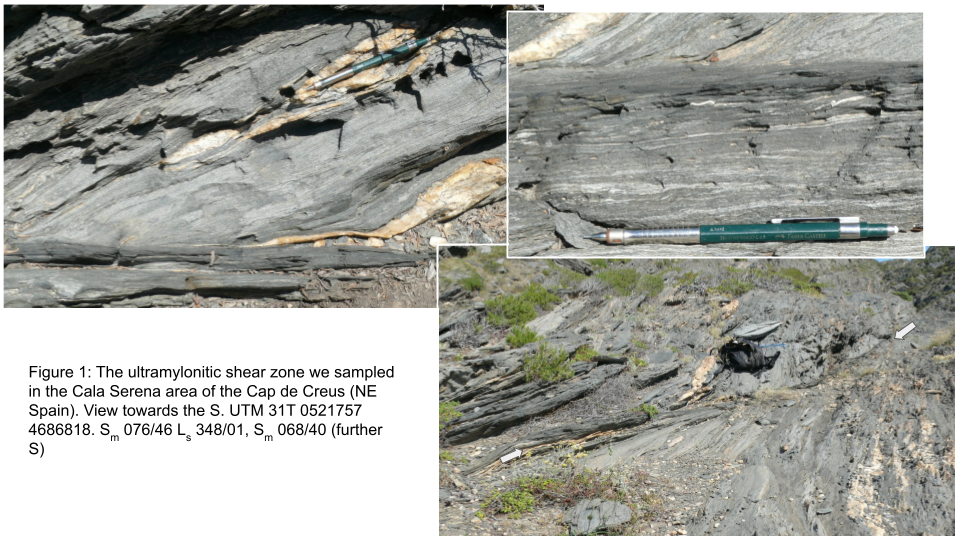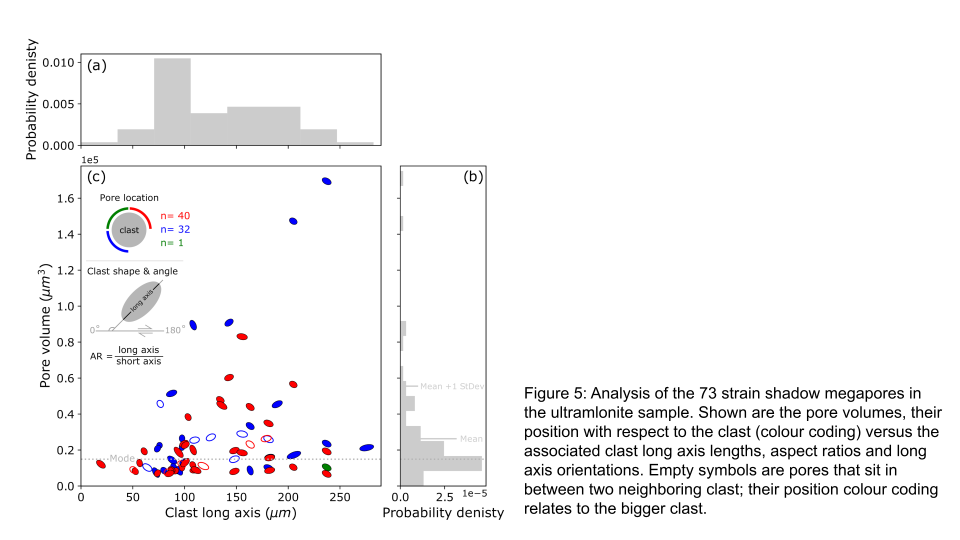Florian Fusseis¹, Craig Allsop¹, James Gilgannon¹, Christoph Schrank²
¹School of Geosciences, The University of Edinburgh, UK, ² School of Earth & Atmospheric Sciences, Queensland University of Technology, Australia
Introduction
Mylonitic shear zones are important fluid-conduits in the Earth’s crust. They host transient and permeable porosity that facilitates fluid transfer and controls fluid-rock interaction. Here we present microstructural observations a fresh, unweathered greenschist-facies ultramylonite from the Cap de Creus (NE Spain) that point to the existence of a previously undescribed type of synkinematic porosity: very large pores that form in the strain shadows of albite porphyroclasts. Our observations from x-ray microtomography and high-resolution backscatter electron microscopy indicate that the pores formed as a consequence of matrix deformation processes in the near field of the rotating porphyroclast. Our 3D data show that the strain shadow megapores have substantial volumes of up to ~150k µm³. The close proximity to another type of transient porosity, creep cavities, in dynamically recrystallized quartz ribbon grains further suggests a hydraulic link between fluid stored in the strain shadow megapores and fluid in the rest of the rock matrix. Our findings add a further component to an emerging picture of the dynamic transport properties of ultramylonitic shear zones, where the formation and destruction of porosity are intrinsically linked to microscale deformation processes.
Shear Zone and ultramylonite
We investigated samples from a shear zone in the Cala Serena area in the north of the Cap de Creus peninsula, NE Spain (Figure 1). This area is characterised by extensive shear zone networks (Fusseis et al., 2006) that formed under retrograde, greenschist facies metamorphic conditions (Fusseis, 2006). Shear zone propagation and networking involved the formation of highly deformed mm-cm wide ultramylonite sheets with very high lateral strain gradients, such as the sampled one. These sheets form predominantly by reaction weakening; metamorphic reactions that contributed to these sheets include the compositional adjustment of a high-temperature biotite to greenschist-facies conditions via Bt1→Bt2+Ms2+Chl+Ilm (Kerrich et al., 1980, 1981), as well as the consumption of albite porphyroclast in the formation of Ab2, Ap and Grt (see Fusseis, 2006, for a detailed description).
In the ultramylonite, both reactions contribute to the formation of a fine-grained (< 15 µm), polyphase matrix composed of Qtz2, Bt2, Ab2, Ms2, with accessory Ilm, Chl, Grt and Ap (Figure 2, see also external link). Within the matrix, the aligned basal planes of Bt2, a large number of aligned phase boundaries as well as aligned Ilm needles define a mylonitic foliation Sm. The polyphase matrix is segmented by monomineralic ribbon grains formed by dynamically recrystallized Qtz2 (Figure 2). The quartz ribbons (recrystallized grain size < 70 µm) are not boudinaged, indicating a similar strength than the polyphase matrix, and exhibit creep cavities similar to those described by Gilgannon et al. (2017, Figure 4). We interpret the dominant deformation mechanism in the polyphase matrix to have been viscous grain boundary sliding, assisted by pressure solution and the precipitation of secondary mineral phases from a fluid via heterogeneous nucleation (Fusseis & Handy, 2008).
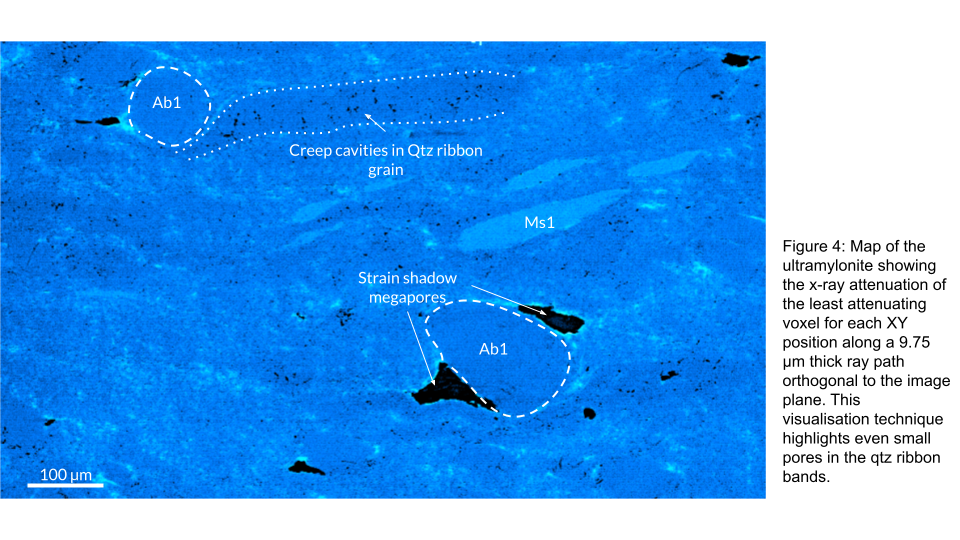
This video shows an image slice that is migrating through our µCT volume. The image shows the x-ray attenuation of the least-attenuating voxel for each XY position along a 9.75 µm long ray path orthogonal to the image plane. This technique is excellently suited to highlight porosity in the sample, which appears black.
Porphyroclasts
The sample is characterised by porphyroclasts, the majority of which are albitic plagioclase (Ab1), with minor Ms1 and rare Bt1 porphyroclasts. These clasts are inherited from the metapsammitic host rock (Figure 3). We focus on the Ab1 porphyroclasts, which appear smaller in the utramylonites; while in the host rock the Ab1 porphyroclasts have long axes of, on average, 207.5 µm (SD 59 µm), in the ultramylonites the long axes are on average 129.9 µm (SD 55.1 µm). The difference in sizes indicates that, during mylonitization, the clasts are dissolved.
The porphyroclasts do not develop any obvious mantles of recrystallized feldspar or reaction products. They appear thus coupled to the matrix and should, consequently, rotate during shearing (Marquez et al., 2014). Deformation in the Cala Serena shear zones was found to be simple-shear dominated, and we thus interpret most clasts to have co-rotated with the top-to-SE directed shear.
In thin sections cut parallel to the stretching lineation and perpendicular to the foliation (XZ), many clasts exhibit a pronounced asymmetry (ellipticity on average 1.61/SD 0.29, compared with 1.51/SD 0.34 in the host rock). Many clasts are inclined with respect to the shear plane, with the long-axes orientation distributions showing two maxima: a majority of clasts are inclined between 20 and 60° against the shear plane (measured antithetically/counterclockwise from Sm), a smaller number oriented between 0 and -50° (clockwise). The strain shadows of the Ab1 porphyroclasts are defined either by Bt2 grains, or pores (Figures 3 and 4).
The mylonitic foliation Sm wraps around the Ab1 porphyroclasts producing asymmetric distortion patterns that indicate stair-stepping across the clasts but are much more subtle than those predicted by Samanta et al. (2002). This may be a function of the matrix grain size.
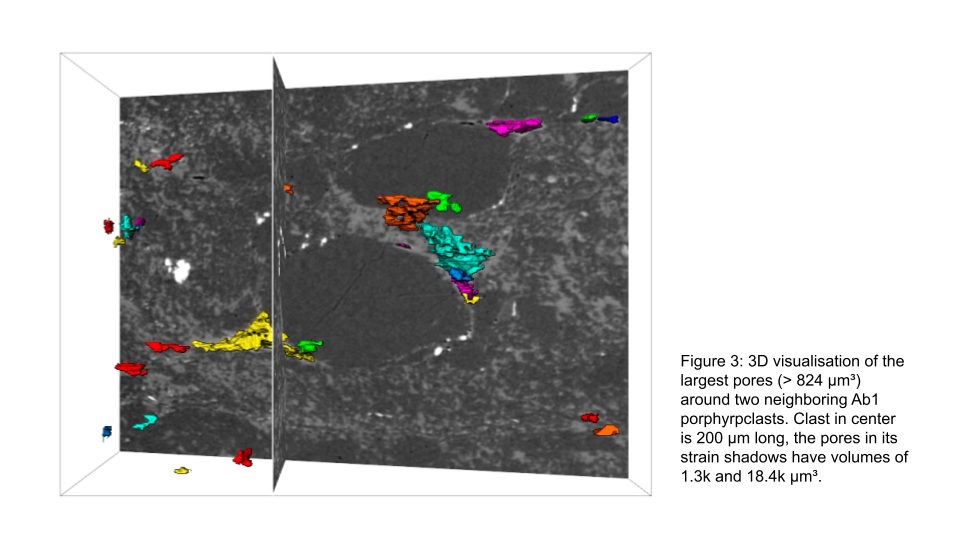
This video shows a thick slice that migrates through a subvolume from a µCT dataset collected from an ultramylonite from the Cap de Creus, NE Spain. Pores have been segmented and labelled - individual pores are colour-coded, and only pores larger than 824 µm³ are shown. Note how pores occupy strain shadows around albite porphyroclasts. As the slides moves backwards through the volume, you see pores disappear that "fall out of" the thick slice at the front.
This video shows a subvolume from a µCT dataset collected from an ultramylonite from the Cap de Creus, NE Spain. Pores have been segmented and labelled - individual pores are colour-coded, and only pores larger than 824 µm³ are shown. Note how pores occupy strain shadows around albite porphyroclasts.
This video shows a subvolume from a µCT dataset collected from an ultramylonite from the Cap de Creus, NE Spain. Pores have been segmented and labelled - individual pores are colour-coded, and only pores larger than 824 µm³ are shown. Note how pores occupy strain shadows around albite porphyroclasts.
Strain shadow megapores
Many, but not all of the Ab1 porphyroclasts exhibit surprisingly large pores in their immediate vicinity. Often, the pores mimic the shapes of classical sigmoidal strain shadows, a few pores also occur on the high-stress sides of the clasts. Some of the pores exhibit evidence for mineral precipitation, but many appear completely void. Our non-invasive three-dimensional synchrotron x-ray micromographic data show that the pores are unconnected to any potential postmylonitic fluid pathways. Combined with the fresh, unweathered appearance of the rock sample and the fact that Ab1 porphyroclasts in the unsheared host rock do not exhibit these pores, we this interpret them as synkinematic porosity.
From the microtomographic data, we analysed 73 Ab1 strain shadow megapores with a volume of over 824 µm³ (3000 voxels). We evaluated the position of the pore with respect to the clast, the pore volume, the clast size and aspect ratio and the clast long axis orientation. Our findings are summarised in Figure 5 (click for larger version). The analysis shows that the majority of strain shadow megapores have volumes between 10,000 and 20,000 µm³. The largest pore has a volume of 170,000 µm³. Pores form around clasts that are, on average 115 µm long (SD 50.5 µm). The majority of the pores (n=40) form at the top right side of clasts, closely followed by the bottom left side (n=32) . These are the clasts' strain shadows. Only one of the analysed pores formed at the top left - high stress - side of a clast. Pores occur around clasts in any of the measured directions, and irrespective of their aspect ratios.
Interpretation
Formation of strain shadow megapores
Hydraulics of ultramylonites
